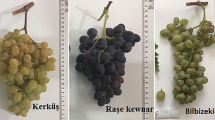Abstract
Winemaking by-products are considered to be a rich source of bioactive compounds. Grape pomace is susceptible to microbial degradation due to the degree of residual moisture, so the drying of this pomace for conservation is considered to be an essential first step. Previous studies concerning the way in which drying affects winery by-products have produced contradictory results. In this study, a new methodology for drying grape pomace in a climatic chamber has been evaluated. Five red grape pomace varieties were dried in a climatic chamber at 40 °C and 10% relative humidity and the phenolic content and antioxidant activity of the dried and wet pomace samples were compared. The results indicate that this drying process is both feasible and beneficial because significant increases in the extractability of phenolic compounds and antioxidant activity were achieved.

Similar content being viewed by others
References
González-Centeno MR, Rosselló C, Simal S et al (2010) Physico-chemical properties of cell wall materials obtained from ten grape varieties and their byproducts: grape pomaces and stems. LWT-Food Sci Technol 43:1580–1586
González-Paramás AM, Esteban-Ruano S, Santos-Buelga C et al (2004) Flavanol content and antioxidant activity in winery byproducts. J Agric Food Chem 52:234–238
Hoye Jr C, Ross CF (2011) Total phenolic content, consumer acceptance, and instrumental analysis of bread made with grape seed flour. J Food Sci 76:S428–S436
Sáyago-Ayerdi SG, Brenes A, Goñi I (2009) Effect of grape antioxidant dietary fiber on the lipid oxidation of raw and cooked chicken hamburgers. LWT-Food Sci Technol 42:971–976
Lavelli V, Sri Harsha PSC, Torri L, Zeppa G (2014) Use of winemaking by-products as an ingredient for tomato puree: the effect of particle size on product quality. Food Chem 152:162–168
Sharma AK, Kumar R, Azad ZRAA, Adsule PG (2015) Use of fine wine lees for value addition in ice cream. J Food Sci Technol 52:592–596
Tseng A, Zhao Y (2012) Effect of different drying methods and storage time on the retention of bioactive compounds and antibacterial activity of wine grape pomace (Pinot Noir and Merlot). J Food Sci 77:H192–H201
Larrauri JA, Rupérez P, Saura-Calixto F (1997) Effect of drying temperature on the stability of polyphenols and antioxidant activity of red grape pomace peels. J Agric Food Chem 45:1390–1393
Sólyom K, Solá R, Cocero MJ, Mato RB (2014) Thermal degradation of grape marc polyphenols. Food Chem 159:361–366
Rajha H, Ziegler W, Louka N et al (2014) Effect of the drying process on the intensification of phenolic compounds recovery from grape pomace using accelerated solvent extraction. Int J Mol Sci 15:18640–18658
da Silva IC, Toaldo IM, de Gois JS et al (2016) Phytochemicals, monosaccharides and elemental composition of the non-pomace constituent of organic and conventional grape juices (Vitis labrusca L.): effect of drying on the bioactive content. Plant Foods Hum Nutr 71:422–428
Goula AM, Thymiatis K, Kaderides K (2016) Valorization of grape pomace: drying behavior and ultrasound extraction of phenolics. Food Bioprod Process 100:132–144
Drosou C, Kyriakopoulou K, Bimpilas A et al (2015) A comparative study on different extraction techniques to recover red grape pomace polyphenols from vinification byproducts. Ind Crop Prod 75:141–149
Chamorro S, Goñi I, Viveros A et al (2011) Changes in polyphenolic content and antioxidant activity after thermal treatments of grape seed extract and grape pomace. Eur Food Res Technol 234:147–155
Chang C-H, Lin H-Y, Chang C-Y, Liu Y-C (2006) Comparisons on the antioxidant properties of fresh, freeze-dried and hot-air-dried tomatoes. J Food Eng 77:478–485
Kim S-Y, Jeong S-M, Park W-P et al (2006) Effect of heating conditions of grape seeds on the antioxidant activity of grape seed extracts. Food Chem 97:472–479
Marquez A, Serratosa MP, Merida J (2013) Anthocyanin evolution and color changes in red grapes during their chamber drying. J Agric Food Chem 61:9908–9914
Marquez A, Dueñas M, Serratosa MP, Merida J (2012) Formation of vitisins and anthocyanin-flavanol adducts during red grape drying. J Agric Food Chem 60:6866–6874
Carrera C, Ruiz-Rodríguez A, Palma M, Barroso CG (2012) Ultrasound assisted extraction of phenolic compounds from grapes. Anal Chim Acta 732:100–104
Mercurio MD, Smith PA (2008) Tannin quantification in red grapes and wine: comparison of polysaccharide- and protein-based tannin precipitation techniques and their ability to model wine astringency. J Agric Food Chem 56:5528–5537
Sarneckis CJ, Dambergs RG, Jones P et al (2006) Quantification of condensed tannins by precipitation with methyl cellulose: development and validation of an optimised tool for grape and wine analysis. Aust J Grape Wine Res 12:39–49
Carmona-Jiménez Y, García-Moreno MV, Igartuburu JM, Garcia Barroso C (2014) Simplification of the DPPH assay for estimating the antioxidant activity of wine and wine by-products. Food Chem 165:198–204
da Silva DIS, Nogueira GDR, Duzzioni AG, Barrozo MAS (2013) Changes of antioxidant constituents in pineapple (Ananas comosus) residue during drying process. Ind Crop Prod 50:557–562
Zhao X, Zhu H, Zhang G, Tang W (2015) Effect of super fine grinding on the physicochemical properties and antioxidant activity of red grape pomace powders. Powder Technol 286:838–844
Acknowledgements
The authors wish to acknowledge support from the Consejería de Innovación Ciencia y Empresa de la Junta de Andalucía from Proyectos de Excelencia AGR6874.
Author information
Authors and Affiliations
Corresponding author
Ethics declarations
Ethical Approval
This article does not contain any studies with human participants or animals performed by any of the authors.
Informed Consent
Not applicable.
Conflict of Interest
Authors declare that they have no conflict of interest.
Electronic supplementary material
ESM 1
(DOCX 621 kb)
Rights and permissions
About this article
Cite this article
Carmona-Jiménez, Y., García-Moreno, M.V. & García-Barroso, C. Effect of Drying on the Phenolic Content and Antioxidant Activity of Red Grape Pomace. Plant Foods Hum Nutr 73, 74–81 (2018). https://doi.org/10.1007/s11130-018-0658-1
Published:
Issue Date:
DOI: https://doi.org/10.1007/s11130-018-0658-1




